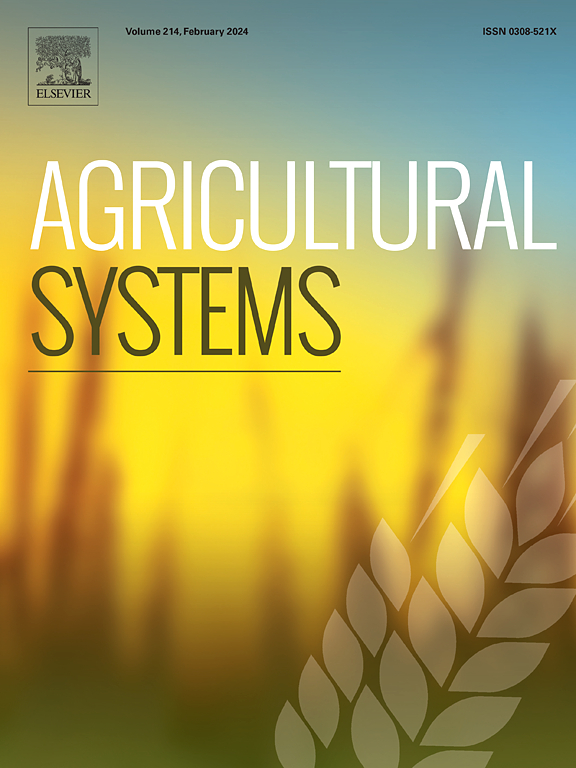放牧牲畜系统产量差距的评估和分析:方法综述
IF 6.1
1区 农林科学
Q1 AGRICULTURE, MULTIDISCIPLINARY
引用次数: 0
摘要
放牧景观覆盖了全球农业用地的很大一部分,对提供生态系统服务、粮食安全和农村生计至关重要。产量缺口概念强调了通过量化当前产量与最高可实现产量之间的差异,实现可持续集约化提高农业产量的潜力。评估产量差距对于在产量增长潜力最大的地区进行有针对性的公共和私人干预和投资至关重要。然而,评估产量差距的方法各不相同,影响了它们一致而准确地识别潜在因素和评估产量风险的能力,特别是在植物和动物之间相互作用增加复杂性的牧场系统中。本综述的目的是概述用于评估和分析以牧场为基础的牲畜生产系统产量差距的方法,并讨论它们如何有助于决策过程。方法查阅文献。结果与结论放牧型畜牧生产系统的产量缺口分析采用了不同的方法。对于基准测试、气候分组、前沿方法和生产系统模型方法,我们提供了简要描述、应用示例、数据要求以及优缺点。具体方法的选择取决于所要解决的研究问题、研究的空间尺度、数据的可用性和计算处理能力。农民通常使用基准方法将其企业的绩效与具有相似特征的其他企业进行比较。气候分类方法应用于更大的空间尺度,以确定在技术上可以选择可持续集约化的区域。前沿方法提供了对技术和经济效率的见解。根据模型的特点,基于生产系统模型的方法可以应用于不同的目的。一般来说,目前用于放牧生产系统产量缺口分析的数学模型很少考虑不同放牧策略、植物种类比例、牧草营养价值和动物选择性放牧的影响。意义基于牧场系统的产量差距评估和分析方法可以为提高现有地区的生产力和资源利用效率提供知识和技术条件,而不是扩展到新的地区。这为满足日益增长的粮食需求,同时保护土地和自然资源提供了机会。有必要将来自产量差距分析的技术见解整合到更广泛的社会、经济和政治框架中,以支持决策者和农民的决策,强调未来研究改进当前方法的必要性。本文章由计算机程序翻译,如有差异,请以英文原文为准。

Assessment and analysis of yield gaps in pasture-based livestock systems: A review of methods
CONTEXT
Grazing landscapes cover a substantial portion of global agricultural land and are essential for the provision of ecosystem services, food security, and rural livelihoods. The yield gap concept highlights the potential for increased agricultural production through sustainable intensification by quantifying the difference between current yields and maximum achievable yields. Assessing yield gaps is crucial for targeting public and private interventions and investments in regions with the greatest potential for production increases. However, methods for assessing yield gaps vary, impacting their ability to identify underlying factors and assess yield risks consistently and accurately, particularly in pasture-based systems where interactions between plants and animals add complexity.
OBJECTIVE
The objectives of this review were to provide an overview of methods used to assess and analyze yield gaps in pasture-based livestock production systems and to discuss how they may aid decision-making processes.
METHODS
Review of literature.
RESULTS AND CONCLUSIONS
Different approaches have been applied for yield gap analysis of pasture-based livestock production systems. For benchmarking, climate binning, frontier methods, and production system models approaches we provide a brief description, examples of applications, data requirements, and advantages and disadvantages. The selection of specific approaches depends on the research questions addressed, spatial scale of the study, data availability and computational processing capacity. Benchmarking approaches are commonly used by farmers to compare the performance of their enterprise to others with similar characteristics. The climate binning approach is applied to larger spatial scales for identifying regions where sustainable intensification technically could be an option. Frontier approaches provide insights on both technical and economic efficiencies. Methods based on production system models may be applied for different purposes, according to the characteristics of the models. In general, mathematical models currently used for yield gap analysis in pasture-based production systems rarely account for the effects of different grazing strategies, plant species proportion, pasture nutritive value and selective grazing by animals.
SIGNIFICANCE
Methods for yield gap assessment and analysis in pasture-based systems can contribute knowledge and technical conditions to increase productivity and resource use efficiency from existing areas rather than expanding to new ones. This provides opportunities to meet the increasing demand for food while conserving land and natural resources. It is necessary to integrate technical insights from yield gap analysis into a broader social, economic, and political framework to support decision making by policy makers and farmers, highlighting the need for future research to improve the current methods.
求助全文
通过发布文献求助,成功后即可免费获取论文全文。
去求助
来源期刊

Agricultural Systems
农林科学-农业综合
CiteScore
13.30
自引率
7.60%
发文量
174
审稿时长
30 days
期刊介绍:
Agricultural Systems is an international journal that deals with interactions - among the components of agricultural systems, among hierarchical levels of agricultural systems, between agricultural and other land use systems, and between agricultural systems and their natural, social and economic environments.
The scope includes the development and application of systems analysis methodologies in the following areas:
Systems approaches in the sustainable intensification of agriculture; pathways for sustainable intensification; crop-livestock integration; farm-level resource allocation; quantification of benefits and trade-offs at farm to landscape levels; integrative, participatory and dynamic modelling approaches for qualitative and quantitative assessments of agricultural systems and decision making;
The interactions between agricultural and non-agricultural landscapes; the multiple services of agricultural systems; food security and the environment;
Global change and adaptation science; transformational adaptations as driven by changes in climate, policy, values and attitudes influencing the design of farming systems;
Development and application of farming systems design tools and methods for impact, scenario and case study analysis; managing the complexities of dynamic agricultural systems; innovation systems and multi stakeholder arrangements that support or promote change and (or) inform policy decisions.
 求助内容:
求助内容: 应助结果提醒方式:
应助结果提醒方式:


